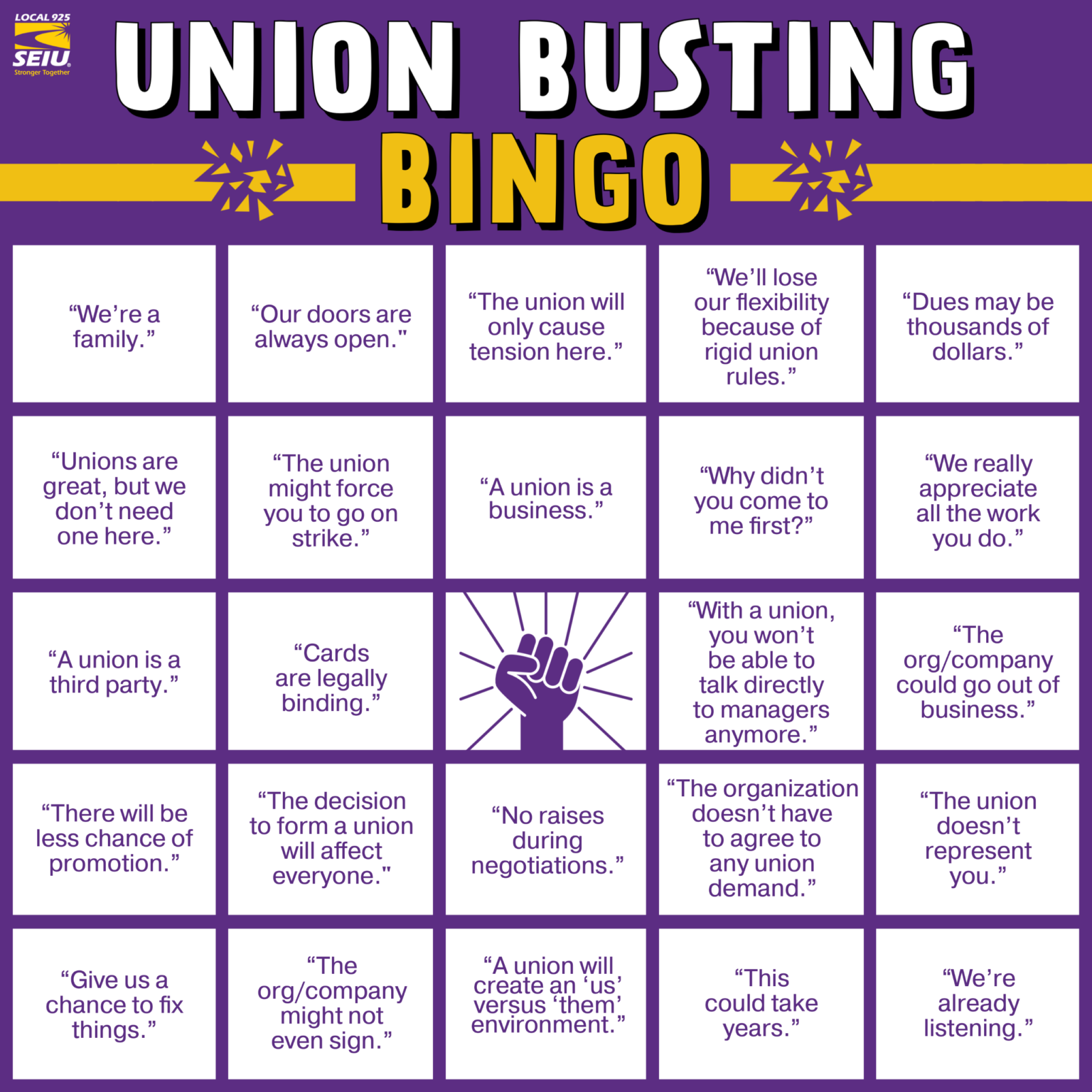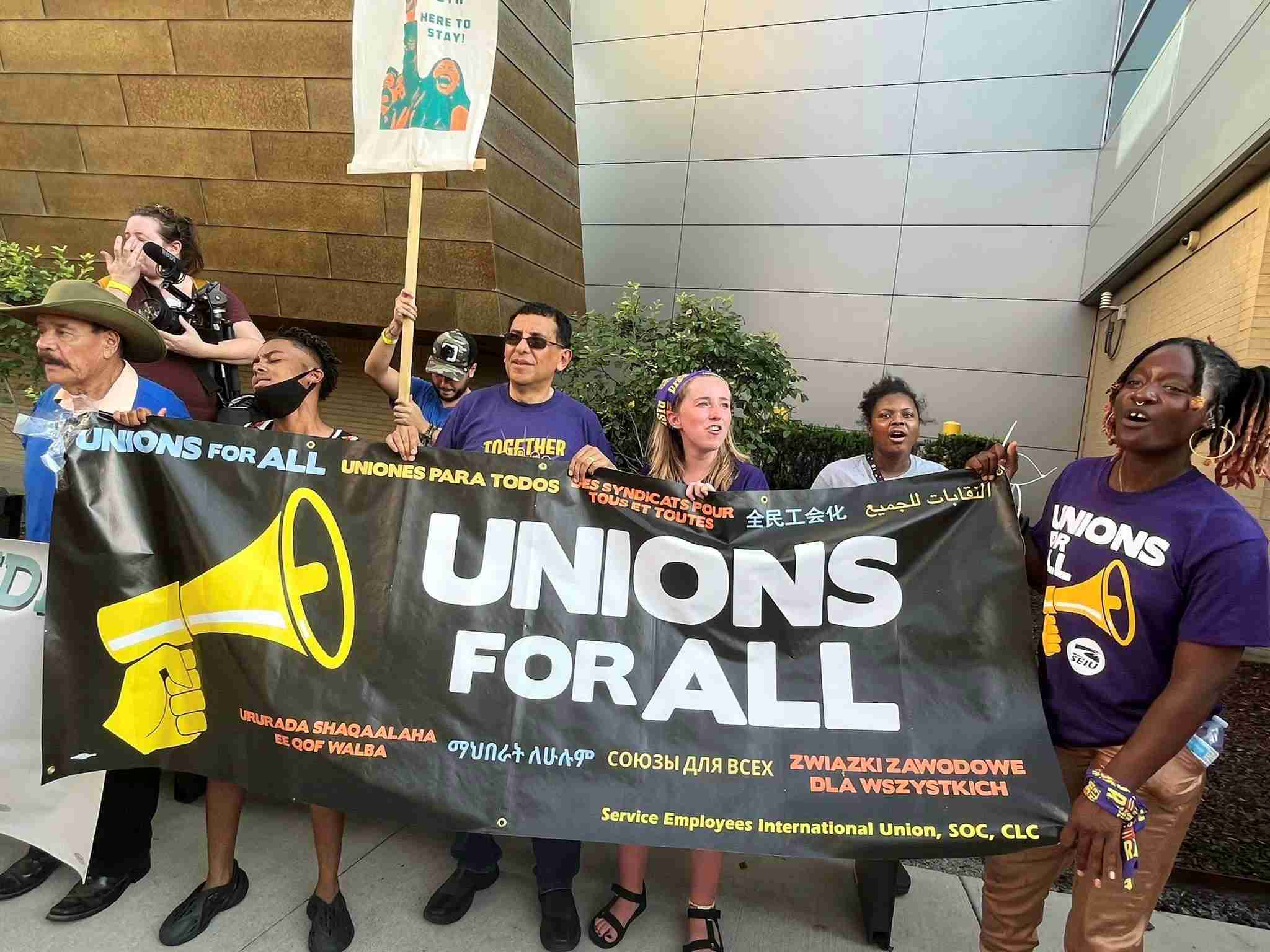Form a Union
What is a union?
A union is simply a group of workers who unite together to have the strongest voice in their workplace. Without a union, management has the ultimate power over everything related to our jobs. But with our union, we can sit down with our employers to negotiate improvements in our wages, benefits and working conditions. In other words, our union means having a seat at the table. We are the people who make our workplaces run everyday, so it’s imperative that we have a real say in our work and our lives.
What have workers won by organizing with SEIU in Wisconsin?
Below are some highlights from SEIU WI’s recent contracts and other union actions, to give you an idea of what you can win when you take the powerful step of uniting with your coworkers. Remember, though: these are only examples. Your union will be your union, and your contract will reflect what you and your coworkers decide to negotiate for, and then vote to ratify.
UnityPoint-Meriter hospital’s 2023-2025 nurses’ contract
- A 14% raise over two years. As the pay scale below shows, a brand new nurse at Meriter makes $41.36 an hour.
- $1500 retention bonus.
- An additional $1.50/hour for time spent training new nurses.
- Grievance procedure that guarantees nurses’ due process rights when a supervisor tries to discipline or fire them.
- Transparent and clear pay scale with yearly salary increases guaranteed for up to 34 years of experience (see image below).
Note: This pay scale was effective as of 5/27/24 and may have experienced gains since then. Class 17 refers to newer nurses, and classes 23 and 26 are more experienced nurses that meet certain requirements.
UnityPoint-Meriter hospital’s 2024-2026 service and support staff contract highlights:
- A 10.15% increase in wages over two years, with an additional $800 bonus.
- Management commitment to review safety training materials, including workers on improving safety protocols, and discussing safety at monthly labor management meetings.
Oakwood Village (retirement and assisted living facility):
- Double time for staff called in or asked to stay over their shift without 24 hours' notice. (When management contested that we had agreed to this, we took it to arbitration and won. Management later disclosed that they owe over $120,000 to the eligible SEIU Wisconsin members).
- Increased pay differentials: $2/hour more for PM Shift, $3/hour for NOC shift, and $5/hour more for the weekend shift.
- $500 towards a flexible spending account.
- $3/hour more to train new nurses.
- In the aftermath of a caregiver being the victim of violence by a resident, the union negotiated new policies to ensure workers’ safety, including time off with pay for the affected worker, and reimbursements for out-of-pocket medical care related to the incident.
UW Health nurses:
- When UW Health created an “Internal Traveler” program to deal with staffing shortages, they said they would pay RNs who volunteered a bonus rate for hours worked as an Internal Traveler. But then the administration tried to pay those RNs a lower rate than promised.
- Working together as a union, nurses filed a complaint with the Wisconsin Department of Workforce Development, and won backpay: for example, one affected RN was paid $2,665.
Janitors at Modern Maintenance, ABM, Regency, UG2 and ESS in Downtown Milwaukee won:
- A 401k retirement plan.
- Additional paid holidays, such as Juneteenth.
SEIU unions outside of Wisconsin have likewise made great strides through unionization. For example, providers working through our Doctors’ Council in Minnesota and Wisconsin recently organized at Allina Health Unity Hospital to address issues such as pay, sick leave, and the need to free up doctors to provide patient care.
The bottom line? Through collective bargaining, we can shape our workplace for the better. Our union amplifies our voice, and the contract we negotiate ensures that workplace improvements are legally enforced.
How do you actually go about forming a union?
In briefest outline, here’s what happens:
- Without alerting management, we gather together a group of workers who are interested in organizing a union. This group is usually very small at the start.
- We ask more and more people to join this group of organizers.
- We gather commitments from all workers to vote YES in a union election, until we have a supermajority of pro-union workers in the workplace.
- This supermajority signs “authorization cards” that call for a union. These authorization cards are then filed with the appropriate labor board.
- An election is held. If they haven’t already, the employer will definitely now launch an anti-union campaign to deter workers from voting Yes. But if over 50% vote Yes, we’ve won our union.
- Negotiate a first contract.
You mentioned an employer-led “anti-union campaign.” What’s that?
Almost all employers don’t want their workers to have a union, because it means they will have to give up absolute decision-making power over our working conditions, pay, and quality of care. They don’t want us to have a say in creating the best conditions for the job, or in what a fair wage looks like.

It’s illegal for employers to threaten or intimidate workers when forming a union. But to prevent workers from building power, they will (for example) send letters, hand out flyers, and hold mandatory meetings to attempt to mislead workers about what a union is. What they say is predictable – so predictable that workers sometimes play “Union Busting Bingo”: see the card to the right (courtesy of our union siblings in SEIU 925 Seattle) for a fun example.
Here’s some examples of what your boss might say or imply:
- A union is a “third party” which aims to disrupt the blissfully informal, family-like relationship that exists between management and workers now. Remember: your union is just that — built by you and your coworkers, who want a say in the decisions being made that affect your work. And your contract will be as formal or informal, issue by issue, as you negotiate it to be. When they say “a union would mean _x_,” always ask yourself: would me and my coworkers do that? Because that’s what they’re saying.
- The union just wants to get your dues money. Here’s the truth: unionized workers collect dues only after a contract with significant wage and benefit increases is ratified by a majority of members. And then, yes, union workers democratically decide to pool their money together in the form of dues because dues are important – strong unions have the resources members need to advocate effectively and make real gains. That’s why employers are worried about them.
- A union only protects bad workers. Nope. Unions protect a fair disciplinary process for everyone, which doesn’t at all take away management’s ongoing responsibility to address poor performance. It only takes away management’s ability to punish workers arbitrarily.
- A union will erode the flexibility which all of you totally enjoy right now. Again, your contract is what you make it. This objection is really code for “I, as your employer, am worried that I won’t have the flexibility to make decisions about your life unilaterally anymore.” And they won’t, it’s true. They’ll have to share power and involve employees in decision-making around wages, benefits, and working conditions.
In short, we can definitely expect our employers to resist having a union. But when we refuse to believe the hype, and stick together, we can also expect to win anyway. And when we unionize, administrators are forced to sit down with workers, as equals, to negotiate a contract which addresses everything we know we need to do our jobs safely and well.
Forming a union sounds great, and important. What should I do next?
If you want to know more about how to join together to make your workplace a better place to work, contact us here: organize@seiuwi.org. All inquiries and conversations will be completely confidential. We’ll hear what your issues are, and talk about solutions.

